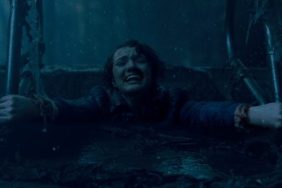Most horror films these days seem addicted to their own high concepts. This bloody-minded need to constantly “re-invent” the horror genre with each outing leads less to innovation, and more to easily-staled trends like J-horror remakes, torture porn, or found-footage frights. And while some of the films in said genres may be of mild note, and some may even be a bit chilling (I do like me some Paranormal Activity), it’s rare that any of them are genuinely terrifying or surprising. How amazing, how awesome, how refreshing then, that a mid-budget, barely-advertised IFC cheapie like Nicholas McCarthy’s The Pact, which makes no pretensions to high concept or stylistic hoopdidoo, can actually be smart, moody, and really, really scary. The Pact is, quite easily, one of the scariest films I’ve seen in a long while.
It’s a simple ghost story. A beleaguered twentysomething (Agnes Bruckner) goes unexpectedly missing while housesitting her recently-dead mother’s home. Her younger sister Annie (Caity Lotz) moves in, and soon discovers an eerie, ghostly presence in the house, and even finds herself being bodily assaulted by an invisible something living there. The two sisters are downtrodden, bickersome young women who are hard without being broody, and wounded without being self-pitying. They feel like real people who seem half-expecting interference by the supernatural. The local cop (a grizzled Casper Van Dien, so that’s where he’s been) of course doesn’t believe her, so she must investigate her dead mother herself, finding, as she would, many scary connections her mom may have had to doers of bad deeds. Sorry to be brief and vague, but I want to retain surprises.

But the story isn’t the important thing. The important thing is the film’s overpowering mood, and the details that give an otherwise rote ghost story so much fearful oomph. Annie’s home, for instance, is a drafty, flimsy, paneled version of cheap urban Hell sitting on a dumpy corner in Culver City, CA. The place looks like it was the home to domestic abuse and alcoholism. Indeed, there is reference to a darkened “punishment closet” where she and her sister were often locked. I know that domestic abuse is practically de rigueur in most ghost stories, but The Pact tempers any banality with cleverly efficient writing, and natural acting.
In an eerie twist reminiscent of Mark Z. Daneilewski’s L.A. hipster horror tome House of Leaves, Annie also discovers that the house, as small as it is, seems to have an extra room she never suspected was there. It makes us suspect, rather unnervingly, that this house may be larger on the inside than it is on the outside.

The Pact has its share of cheap jump scares, along the vein of the sudden appearance of a creepy image or ghostly shape at the frame’s periphery. Jump scares are all well and good, and can often be the only redeeming things about certain horror films (see: The Woman in Black), but The Pact has such a strong mood that the jump scares don’t necessarily feel cheap. I found myself getting legitimately scared. The Pact also has its share of ghostly imagery, which can also feel cheap, and have also been overused by plenty of ghost movies (see Insidious). But director McCarthy seems to have an uncanny sense of craft when shooting the spook scenes; he seems to know the pace and the camera placement required for maximum effect.
This is only McCarthy’s first feature film, and it’s a corker. The film is only getting a small release, and has not been advertised too much. It’s something that you should seek out, as it is a rare thing: a good, well-made, genuinely scary horror movie.







